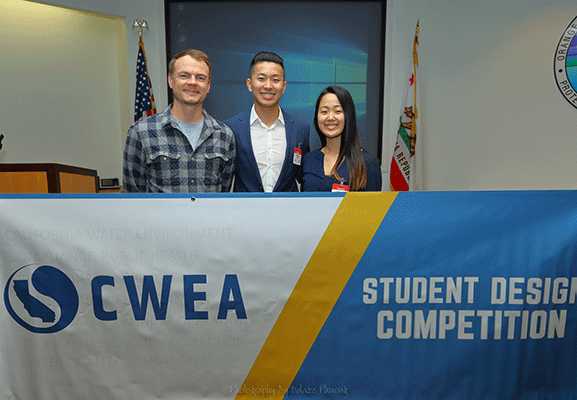Undergrads Win State Contest, Head to Nationals
 June 21, 2018 - Two recent civil engineering graduates have qualified for a national competition after winning at the state level in a contest sponsored by the California Water Environment Association.
June 21, 2018 - Two recent civil engineering graduates have qualified for a national competition after winning at the state level in a contest sponsored by the California Water Environment Association.
Jessica Yunji Park and Windsor Takashi Lee, both of whom received bachelor’s degrees last week, won the student design contest held last month at the Orange County Sanitation District in Fountain Valley. The challenge was to prepare and present a design that helps solve a water quality issue; Park and Lee beat out teams from USC and Cal Poly Pomona, as well as another UC Irvine team, to take the prize.
Entrants had to evaluate alternative ideas, perform calculations and recommend solutions to a panel of judges, both in a written report and in an oral presentation. Park and Lee’s team – dubbed Takashi Hydraulics, Inc. – evaluated the replacement of two existing, but aging, wastewater pump stations in Orange County with a single, new station. Their work studied the feasibility of two alternatives for the gravity (upstream) system, two alternatives for the force main (downstream) system, and three alternatives for the pump configuration, then proposed a recommended design. The team also drafted process flow diagrams, civil and mechanical plans and profile sheets for their recommended approaches, and developed cost estimates for each alternative.
“I can tell you firsthand that they faced tough competition, but Windsor and Jessica gave a great presentation and the judges were equally impressed by their written report,” said Joel Lanning, assistant professor of teaching, who encouraged them to enter and attended the competition.
“The challenging part of it was that we had to service a very broad range of flows,” Lee said. “We had to choose that sweet spot where we could still operate for these very low flows while also being able to service storms,” he said, explaining that wastewater systems must process storm water as well as sanitation flows.
The team faced other challenges as well. The four-mile long sewer system runs through three different cities, including an area near a Navy facility that contains contaminated aquifers. “It was explicitly stated that it was up to us to prevent the spread of contamination,” Lee said. He and Park designed a shallow system that mitigated interference with the existing water table.
Park added that another challenge was the sheer volume of information and detail required by the work. “We were kind of taken aback in the beginning,” she said, “but once we went through it all, that helped a lot.”
She also said she and Lee were “in shock” when they learned they had won.
“Shock and surprise,” Lee said, “but we are really excited because it means all the work we put into it paid off.”
The team is now looking forward to competing at the national Water Environment Federation Student Design Competition during the WEFTEC annual conference, Sept. 29-Oct. 3 in New Orleans.
-- Anna Lynn Spitzer
